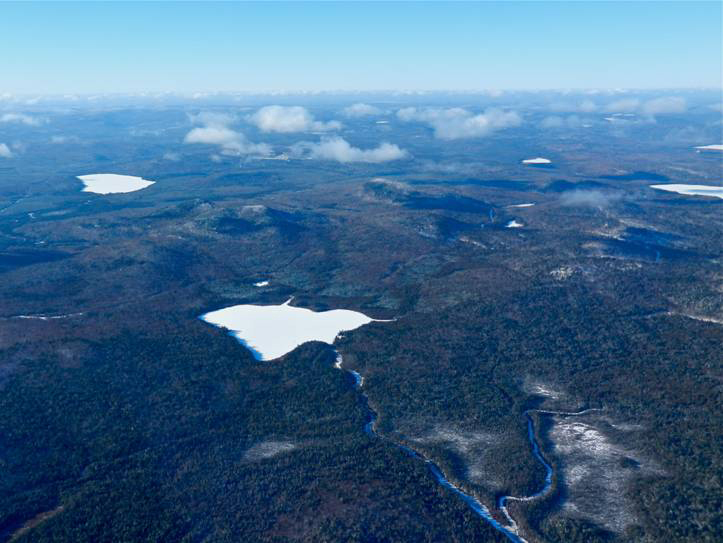The state Department of Environmental Protection, working with an out-of-state contractor, has proposed new mining rules that already are sparking controversy.
The department released a 78-page draft late Friday and posted it on its website. When asked for comment on Monday, several legislators, Board of Environmental Protection members and environmental groups said they hadn’t had time to review the proposal, which would change rules for the first time in 20 years.
But Nick Bennett, staff scientist of the Natural Resources Council of Maine, said even a cursory reading revealed that current mining rules would be gutted.
“I think we are headed in a direction that makes safe mining in Maine much less likely,” Bennett said. “The draft rules … are being changed to make life easier for the mining industry – pure and simple.”
The state’s largest landowner, JD Irving of St. John, New Brunswick, has expressed interest in mining at Bald Mountain in Aroostook County for gold, silver and other deposits. The metal are estimated to be worth as much as $7 billion, according to geologist John S. Cummings of Texas, who discovered the deposits there in the late 1970s.
“Based on a quick look, the draft mining rules look fairly comprehensive,” said Jym St. Pierre, Maine director of Restore: The North Woods and a participant in the last rule-making process, in the early 1990s.
“However, they hide a major concern. They are written with the assumption that Maine should say ‘yes’ to mining and that we should try to make mining reasonably safe. They are not written to give the public officials … a good opportunity to say, ‘No, the short-term benefits of mining are not worth the long-term costs to Maine’s fragile and valuable natural environment.’ “
DEP officials declined to comment on the draft, saying they were making the rules public prior to the Sept. 12 meeting of the Bureau of Environmental Protection so there would be time for public review.
Heather Parent, director of policy development and implementation for DEP’s rule-making team – assisted by consultant North Jackson Co. of Marquette, Mich., which has ties to the mining industry – said staff wouldn’t elaborate on the draft rules until board members had a chance to review them.
Members of the board contacted for comment said they were waiting to respond until DEP staff formally presented the document to them.
But environmental watchdogs who have been tracking the legislation that called for the new rules since early 2012 said they found several proposed changes disturbing.
Most criticism focused on compatibility of mining with surrounding land use, groundwater protection, financial assurances should a mining operation fail and less stringent requirements for cleanup of abandoned sites.
The draft rules say mining operations must be compatible with surrounding non-mining land use, St. Pierre said.
“By their nature, mines are incompatible with Maine’s natural landscape, so how can this standard be met?” he said.
Under the proposal, mining is excluded in such places as national and state parks and historic sites, national wilderness areas and refuges, designated lands such as the Allagash Wilderness Waterway, state-owned wildlife management areas and public reserve lands and lots.
“This is good, but additional areas should be listed,” St. Pierre said.
Under the draft rules, the DEP would drastically ease restrictions on groundwater pollution, Bennett said. “Under existing rules, you can’t violate groundwater standards, period.”
But under the draft, “the DEP is using a very strange definition of ‘groundwater,’” he said. Typically applied to any below-ground supplies, “groundwater” as defined in the rules excludes “such waters as are confined and retained completely upon the property of one person (or company) and do not drain into or connect with any other waters of the State.”
“That really worries me,” Bennett said – the definition appears to allow a company to pollute water on its property, as long as it can argue that its groundwater does not connect with other water in Maine
“It seems absurd,” Bennett said.
Bennett also said he disagreed with what he said were vague requirements for monitoring water quality, and how often testing should be done.
Sampling should be done weekly rather than four times a year, he said, and monitoring wells should have to be closer to the mines than the new rules would allow.
The rules would require mining companies to pay for 50 percent of cleanup costs for the first five years, Bennet said, but many operations go bankrupt within five years. The financial assurances – held in trust – should be 100 percent from the start, he said.
Finally, rather than allow mining enterprises up to 30 years to remediate a site – return it to its original condition – the cleanup should be required within 10 years to ensure it is completed, Bennett said.
The Board of Environmental Protection will review the draft and then schedule a public hearing.
Written comments will be taken and possible revisions made before the board votes on provisional adoption of the changes.
The draft document is a “major substantive change” in rules, so the Legislature must vote on the rules before they can be enacted. The process will not be completed until 2014, said Parent.
North Cairn can be contacted at 791-6325 or at: ncairn@pressherald.com
Send questions/comments to the editors.


